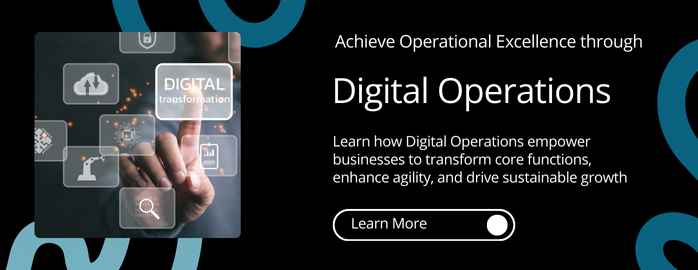Businesses today can no longer rely on traditional and static operations for staying competitive. The shift from manual processes to automation was just the beginning. To truly thrive in this digital-first world, enterprise operations must be intelligent, self-optimizing, and driven by AI. This is where the area of digital operations comes in, with the idea of incorporating agility and automation into business processes to improve performance.
Digital operations go beyond basic automation, integrating modern transformation drivers such as AI, real-time analytics, and cloud computing to empower business functions to adapt dynamically. They enable businesses to scale and optimize operations in real-time, through AI-powered ITSM, self-healing networks, predictive customer engagement, and more.
More importantly, digital ops are a critical step in the digital transformation journey. While IT Modernization provides the foundation and Digitalization automates workflows, digital ops span end-to-end digitization, with the aim of unifying data from different sources.
Transformation is a multi-step journey, and these efforts start from something as basic as digitization, which is focused on converting analog processes to digital formats. Subsequently, digitalization aims to automate repetitive tasks, and digital ops takes this further to decrease human intervention.
Before a business can operate digitally, it needs the right IT infrastructure upgrades to enable scalability and cloud-readiness. IT modernization focuses on building these capabilities, laying the foundation for cloud, AI, and automation functionalities. It includes:
Example: A telecom company upgrades its core network infrastructure to a cloud-native architecture, making it easier to automate and integrate AI-driven services later.
Digitalization focuses on bringing in basic automation into processes, using digital technologies to optimize business operations and workflows. Here are some examples of digitalization efforts:
Using robotic process automation (RPA) to reduce manual input
This is where businesses move beyond automation and embrace self-optimizing, AI-driven operations. Unlike digitalization, which focuses on basic process automation, digital ops prioritize reducing manual efforts by making decisions proactively.
Digital transformation can be seen as the final step in this process, moving beyond optimization and efficiency to redefine how businesses generate value. Subsequently, by leveraging intelligent digital operations, businesses can create entirely new revenue streams, business models, and market opportunities that were previously impossible.
At this stage, digital capabilities such as AI, automation, cloud computing, IoT, and data analytics are fully integrated into business processes. This allows enterprises to explore the following:
Automotive: A traditional auto manufacturer transforms into a ‘mobility-as-a-service’ provider, offering pay-per-use transportation services. They leverage cutting-edge technologies in the mobility space, such as AI-driven fleet management, predictive maintenance, and smart vehicle connectivity to support their ambitions.
Manufacturing – Equipment-as-a-Service (EaaS): Instead of selling machines, companies offer them as a service with predictive maintenance and uptime guarantees.
Telecom – AI-Driven Network Optimization: Telecom providers use AI-based network performance monitoring as a premium service for enterprise customers.
Retail – AI-Powered Personalization: Retailers monetize customer insights by offering personalized product recommendations and data-driven advertising.
Healthcare – Remote Patient Monitoring Services: IoT-enabled wearables and telemedicine platforms create new care delivery models.
Digital ops mark a departure from traditional and manual workflows. The main idea is to incorporate intelligent and self-optimizing processes into business operations. Furthermore, this shift is made possible by advances in AI and cloud, and with a goal of offering seamless digital experiences to customers.
AI is the key driver in tackling the inefficiencies that can be found in manual processes. The benefit comes from the fact that these AI models can continuously monitor systems or data to predict outcomes, optimize processes, and ultimately make decisions autonomously. Few of the elements that enable all this are predictive analytics, ML algorithms, and AI-based personalization.
Hyperautomation goes beyond automating repetitive tasks, and integrates concepts like AI and RPA into workflows, further reducing human intervention. From routine tasks such as data entry and invoicing to incident management, the idea is to orchestrate the process end-to-end. Additionally, self-healing systems are designed to take corrective action almost immediately and without needing the involvement of a human agent.
By now, its clear that digital operations require IT infra that can support real-time and data-intensive operations. Cloud platforms enable this by offering on-demand resource allocation, distributed computing, and integrating all the digital tools necessary. Various cloud technologies at the infra level support transformation; these could be hybrid or multi-cloud architectures, edge computing, or API-driven architectures.
All these efforts zero-in on delivering superior customer experiences. Customers today expect personalized and real-time interactions across all the channels they interact with. The integration of AI, analytics, and digital touchpoints allows businesses to deliver these seamless, connected experiences, improving satisfaction and loyalty. As mentioned earlier, AI enables dynamic personalization, but this transformation also drives omnichannel engagement, and automates the customer support process.

Digital ops form a part of bigger digital transformation efforts in a company. They aim to go beyond simple process automation, making it intelligent and self-optimizing. Certain drivers such as data-driven efforts, hyperautomation, supporting cloud infra, and connected digital experiences make it possible.
Digital ops bring the ability to automate complex workflows, make decisions backed by real-time data, and deliver seamless customer interactions. Investing in Digital Operations means building a self-optimizing, agile enterprise that can adapt to challenges and capitalize on new opportunities.